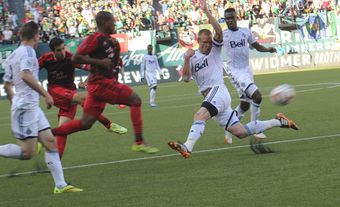Long-Distance Running
Long-Distance Running refers to the running, both on and off the track, of distances longer than 3000 m. During the 1970s the upsurge of interest in long-distance running in Canada and elsewhere gained much of its impetus from the growing popularity of running as a form of exercise to improve FITNESS. Increased numbers of entries in clubs and organized races forced improvements in race categorization. The simple 4-division arrangement of men's and women's novice and men's and women's open was enlarged to include men's and women's masters, with 10-year age stages and under-18 age divisions. However, the 26-mile, 385-yard (42,195 m) marathon, for most, remained the golden challenge.History
The marathon commemorates an event in ancient Greece; Pheidippides' run from the battlefield at Marathon to Athens (c 35 km) to announce victory. The first marathon race was in the 1896 Olympics; in the 1908 Olympics, the 26-mile distance from Windsor to London, Eng, came up a little short of the place at Windsor Castle from which the Royal Family was due to observe the start. This was corrected by adding 385 yards. By an administrative quirk the extra yards were adopted in the official distance in 1924.
Long-Distance Competition
The burgeoning interest in running has revived some defunct Canadian races. The Old Home Summer 10-Miler resurrected the Halifax Herald Modified Marathon, which was first run in 1907. It drew crowds until 1942, when WWII halted its continuation. In 1926, responding to his father's bribe of a trip to compete in the Boston Marathon, a 21-year-old miner from Sydney, NS, John C. Miles, ran the Modified and finished first. In Boston, Miles battled reigning Olympic champion Albin Stenroos and the race favourite, Bostonian Clarence DeMar, to win the 1926 Marathon in a time of 2:25:40, 4 minutes faster than the previous course record.
In 1987 North America's oldest race, the Hamilton "Around-the-Bay" race, had been run 77 times since its inception in 1894. The route, now standardized at 30 km, a little short of its original distance, launched the career of another great runner, Tom LONGBOAT. In 1906 Longboat defied gamblers' odds of 60-1 in winning the Hamilton race. He won the Boston Marathon in 1907 and, despite a US protest about his amateur status, competed for Canada in the marathon of the 1908 London Olympics, but did not finish.
Other Canadians who have won the Boston Marathon are Jack Caffery (1900, 1901), Fred Cameron (1910), James Duffy (1914), Édouard Fabre (1915), Dave Komonen (1934), Walter Young (1937), Gérard Côté (1940, 1943, 1944, 1948), Jerome Drayton (1977) and Jacqueline Gareau (women's open, 1980). Another noteworthy victory was William Sherring's first-place finish at the mid-Olympiad festival in Athens, Greece, in 1906.
Newer races offer unique challenges to racers. The Nunavut Midnight Sun Marathon is run on the few gravel roads surrounding the Hamlet of ARCTIC BAY, Nunavut some 720 km above the Arctic Circle. It takes place in July, when the sun never sets in the Arctic. Where this run, like many other races, is a test of individual endurance, the Banff-Jasper Relay is a test of team endurance. In 1982 the Toronto Olympic Club set a new course record of 16:47:45.
Marathons are staged in most major Canadian cities. These and shorter races are run by notable men's open racers such as Jerome Drayton, Canadian marathon record, 2:10:09, Fukuoka, Japan, 1975; Paul Bannon, 1978 Commonwealth Games marathon medallist; Peter Maher, 1987 Ottawa Marathon, 2:12:58; Art Boileau, 1987 Los Angeles Marathon winner, 2:13:08; Dave Edge, PB-2:11:51 and Peter Butler, Canadian 10 km record holder with a time of 28:19:07.
Women's open notables include Cynthia Hamilton, 1982 New York Marathon, 2:38:12; Linda Staudt, 1981 Montréal Marathon, 2:33:33; Odette Lapierre, 4th place women's open, 1987 Boston Marathon, 2:31:36; S. Ruegger, PB-2:31:53; Jacqueline Gareau; and Lynn Williams who holds the Canadian women's records for the indoor mile (4:34:7½) and the indoor 3000 m (8:50:80) and won the 1987 Sun 10 km in 32:14.
As well, there is a wide field of masters' competitors in every race. Men's master Bob Moore was 7th in the Vancouver International Marathon with a time of 2:24:10 and 10th in the Bermuda Marathon at 2:30:50. Women's master Diane Palmason became master Canadian and North American female champion when she was 3rd overall woman finisher in the 1981 Oakland marathon. World record holder Art Taylor had times in the 1982 North American and Canadian championships, 50+ age division, of 35:08 for 10 000 m and 17:04:08 for 5000 m.
Some athletes are enticed to run even greater distances. Al Howie holds the Canadian records for several ultra marathon distances - 50 km in 3:12:46, 50 miles in 5:35:12, 100 km in 7:30:31, 100 miles in 14:06:18 as well as the Canadian 24-hour race record with a distance of 150 miles, 352 yards. Before attempting unsuccessfully to break his own 24-hour race record in the 1983 Sri Chinmoy 24 Hour Race, Howie ran from Winnipeg to Ottawa, a distance of 1500 miles. However, this distance is overshadowed by Kanchan Stott's achievement. On 29 November 1983, 37-year-old Stott reached Halifax, NS, 207 days after leaving Victoria, BC, completing the first cross-Canada run by a woman and the longest recorded run (6688 km) by a woman.
Long-Distance Running Today
The sport of running is taken up by thousands of Canadians each year, and it has become accessible via runners such as John STANTON, Canada's best-known expert on recreational running. With his business the Running Room, he has advocated for improved health and fitness through long-distance running, offering training on various distances from 5 km runs to full marathons.

 Share on Facebook
Share on Facebook Share on X
Share on X Share by Email
Share by Email Share on Google Classroom
Share on Google Classroom




